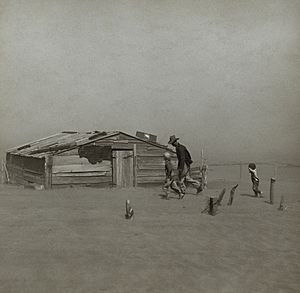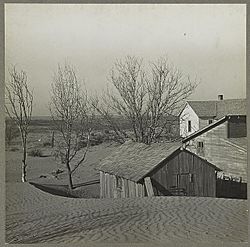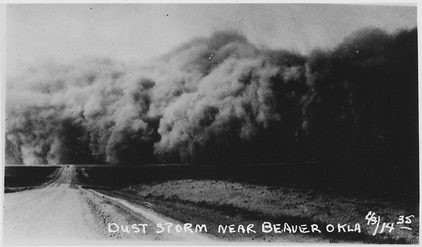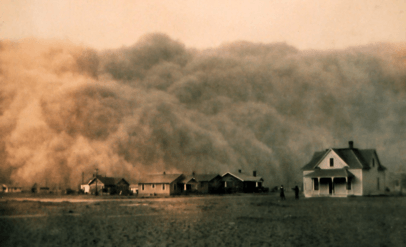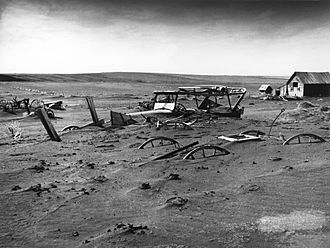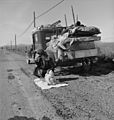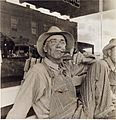Dust Bowl facts for kids
The Dust Bowl was a time in the 1930s when parts of the United States and Canada faced terrible dust storms and long periods without rain, called droughts. This area included prairie regions like Saskatchewan and Manitoba in Canada, and states like Oklahoma, Texas, and New Mexico in the U.S. These storms caused huge problems for the farms, the environment, and the way people made a living in these areas.
Contents
What Caused the Dust Bowl?
Most people living in the Dust Bowl region were farmers. For many years, they farmed the land very intensely. They plowed up a lot of the natural grass that held the soil in place. When there wasn't enough rain, the soil became very dry and loose.
When strong winds blew across these dry fields, they picked up huge clouds of dust. These dust clouds covered cities, towns, and farms, making the land impossible to farm. It was like the soil just blew away!
The Famous "Black Sunday" Storm
One of the worst dust storms happened on April 14, 1935. It was so bad that people called it Black Sunday. This storm covered many cities in thick, black clouds of dust. It was so dark that you couldn't see the sky or even a few feet in front of you.
One writer, Timothy Egan, said that the Black Sunday storm carried away twice as much dirt as was dug to create the Panama Canal. This shows just how much soil was lost in that one terrible day.
How the Dust Bowl Affected People
The Dust Bowl is still seen as one of the worst environmental disasters in the history of the United States. Thousands of people got sick or even died from breathing in the dust. Others faced starvation because their crops failed.
Many people who survived lost everything they owned. They had to leave their homes and farms in the Dust Bowl area. These people moved to other parts of the country, hoping to find work. They were often called "Dust Bowl refugees."
Learning from the Disaster
The serious problems caused by the Dust Bowl taught people important lessons. Farmers started using better methods to protect the soil. These included:
- Crop rotation: Planting different crops in the same field each year.
- Reforesting: Planting trees to help hold the soil.
- Other ways to keep the topsoil healthy and prevent it from blowing away.
The stories of the Dust Bowl also inspired many artists. People created songs, books, and artworks to share what it was like to live through the dust storms. Some famous examples include:
- The novels The Grapes of Wrath and Of Mice and Men by John Steinbeck.
- The songs of folk music singer Woody Guthrie.
- The photography of Dorothea Lange, who took famous pictures of Dust Bowl refugees and their families.
Photo gallery
- Hover over each photo to view its label. Click on the picture to make it bigger.
-
An Oklahoma dust storm (1935)
-
A dust storm covers homes (Texas, 1935)
-
Vehicles and machines buried in dust (South Dakota, 1936)
-
Famous picture of Dust Bowl refugees (1936)
Images for kids
-
A farmer and his two sons during a dust storm in Cimarron County, Oklahoma, April 1936. Iconic photo taken by Arthur Rothstein.
-
A dust storm; Spearman, Texas, April 14, 1935
-
"Broke, baby sick, and car trouble!" – Dorothea Lange's 1937 photo of a Missouri migrant family's jalopy stuck near Tracy, California.
-
"Dust bowl farmers of west Texas in town", photograph by Dorothea Lange, June 1937.
See also
 In Spanish: Dust Bowl para niños
In Spanish: Dust Bowl para niños


